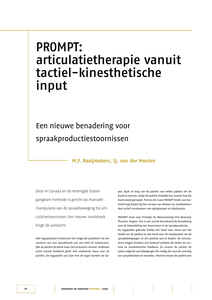This chapter describes the growing influence of point-of-care diagnostics (POCD) on the daily lives of citizens, their immediate families, and healthcare providers. With a view to the future, the most important contemporary developments in this field are discussed, such as noninvasive sensor technology in the diagnostic process, practical examples of point-of-care diagnostics (POCD), including the quantify-self movement and infrared technology. Cost-effectiveness, adoption of POCD, and the contribution of POCD innovations to self-management and health literacy are also discussed. Developments in which deep learning and artificial intelligence are used to make the diagnostic results more reliable are also conferred, such as the development of point-of-care Internet diagnostics. The discussion of professional advice dilemma’s in POCD, the patient’s appreciation of POCD, and ethical and philosophical considerations conclude this chapter.
DOCUMENT

This report presents the highlights of the 7th European Meeting on Molecular Diagnostics held in Scheveningen, The Hague, The Netherlands, 12-14 October 2011. The areas covered included molecular diagnostics applications in medical microbiology, virology, pathology, hemato-oncology,clinical genetics and forensics. Novel real-time amplification approaches, novel diagnostic applications and new technologies, such as next-generation sequencing, PCR lectrospray-ionization TOF mass spectrometry and techniques based on the detection of proteins or other molecules, were discussed. Furthermore, diagnostic companies presented their future visions for molecular diagnostics in human healthcare.
DOCUMENT

DOCUMENT

INTRODUCTION: To provide a state of the art on diagnostics, clinical characteristics, and treatment of paediatric generalised joint hypermobility (GJH) and joint hypermobility syndrome (JHS).METHOD: A narrative review was performed regarding diagnostics and clinical characteristics. Effectiveness of treatment was evaluated by systematic review. Searches of Medline and Central were performed and included nonsymptomatic and symptomatic forms of GJH (JHS, collagen diseases).RESULTS: In the last decade, scientific research has accumulated on all domains of the ICF. GJH/JHS can be considered as a clinical entity, which can have serious effects during all stages of life. However research regarding the pathological mechanism has resulted in new potential opportunities for treatment. When regarding the effectiveness of current treatments, the search identified 1318 studies, from which three were included (JHS: n = 2, Osteogenesis Imperfecta: n = 1). According to the best evidence synthesis, there was strong evidence that enhancing physical fitness is an effective treatment for children with JHS. However this was based on only two studies.CONCLUSION: Based on the sparsely available knowledge on intervention studies, future longitudinal studies should focus on the effect of physical activity, fitness, and joint stabilisation. In JHS and chronic pain, the effectiveness of a multidisciplinary approach should be investigated.
DOCUMENT

This paper presents four Destination Stewardship scenarios based on different levels of engagement from the public and private sector. The scenarios serve to support destination stakeholders in assessing their current context and the pathway towards greater stewardship. A Destination Stewardship Governance Diagnostic framework is built on the scenarios to support its stakeholders in considering how to move along that pathway, identifying the key aspects of governance that are either facilitating or frustrating a destination stewardship approach, and the required actions and resources to achieve an improved scenario. Moreover, the scenarios and diagnostic framework support stakeholders to come together to debate and scrutinise how tourism is managed in a way that meets the needs of the destination, casting new light on the barriers and opportunities for greater destination stewardship.
DOCUMENT

PROMPT is a tactile-kinesthetic approach for assessment and treatment of speech production disorders. PROMPT uses tactile-kinethetic cues to facilitate motor speech behaviors. Therapy is structured from basic motor speech patterns with much tactile-lkinesthetic cueing, towards complex motor speech activities with less cueing. This article describes the purpose and contents of PROMPT assessment and therapy.
DOCUMENT

Tot op heden bestond er geen onderzoeksinstrument dat betrouwbaar differentieert tussen broddelende en stotterende clienten. Een door de eerste auteur ontwikkelde test voor spraakmotorische controle op woordniveau is genormeerd en gevalideerd voor broddelende, stotterende sprekers en controles. Dit unieke instrument heeft een differentiaal diagnostische waarde binnen de vloeiendheidsstoornissen.
DOCUMENT

Onderzoek naar differentiaal diagnostische karakteristieken tussen broddelen en stotteren heeft geleid tot internationaal te gebruiken meetbare en onderscheidende spraakkarakteristieken.
DOCUMENT
De checklist broddelkenmerken is toegepast op een populatie (n=354) niet-vloeiend sprekende kinderen, kinderen met leermoeilijkheden en controles in de leeftijd 10;6 -12;11 jaar. Een aangepaste versie inclusief normering met diagnostische waarde is het resultaat
DOCUMENT
Saliva diagnostics have become increasingly popular due to their non-invasive nature and patient-friendly collection process. Various collection methods are available, yet these are not always well standardized for either quantitative or qualitative analysis. In line, the objective of this study was to evaluate if measured levels of various biomarkers in the saliva of healthy individuals were affected by three distinct saliva collection methods: 1) unstimulated saliva, 2) chew stimulated saliva, and 3) oral rinse. Saliva samples from 30 healthy individuals were obtained by the three collection methods. Then, the levels of various salivary biomarkers such as proteins and ions were determined. It was found that levels of various biomarkers obtained from unstimulated saliva were comparable to those in chew stimulated saliva. The levels of potassium, sodium, and amylase activity differed significantly among the three collection methods. Levels of all biomarkers measured using the oral rinse method significantly differed from those obtained from unstimulated and chew-stimulated saliva. In conclusion, both unstimulated and chew-stimulated saliva provided comparable levels for a diverse group of biomarkers. However, the results obtained from the oral rinse method significantly differed from those of unstimulated and chew-stimulated saliva, due to the diluted nature of the saliva extract.
DOCUMENT
